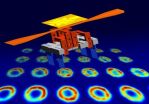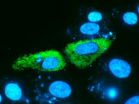(Press-News.org) A team of researchers led by Associate Professor Yan Jie from the Department of Physics at the National University of Singapore (NUS) Faculty of Science has identified three new distinct overstretched deoxyribonucleic acid (DNA) structures caused by mechanical stretching. This discovery provides a clear answer to a long-running debate among scientists over the nature of DNA overstretching.
Debate on Possible DNA Structural Transitions
Recent single-molecule studies revealed that mechanical stretching could induce transitions to elongated DNA structures. Three possible elongated DNA structures have been proposed, namely: a single-stranded DNA under tension, DNA bubbles consisting two parallel, separated single-stranded DNA under tension, and a new form of base-paired double-stranded DNA. The existence of the three transitions has been heavily discussed among scientists for some 17 years.
To fully understand the nature of DNA overstretching, the team led by Assoc Prof Yan, which comprises members from NUS, the University of Minnesota and the Massachusetts Institute of Technology, explored the possible structural transitions.
Three Distinct Transitions Revealed
In their recent study, the researchers systematically investigated the three possible transitions induced by mechanical stretching, with methods to control DNA construct, temperature, force and salt concentration. Their data successfully identified all the three proposed structures and fully characterised their respective thermo-mechanical properties. These findings were first published on the online version of the Proceedings of the National Academy of Sciences on 19 February 2013.
These findings complete the picture about the structures of DNA under tension, providing a conclusion to the 17-year-old debate.
An illustration of three distinct elongated DNA structures produced by mechanical stretching (Image credit: NUS)
Biological Implications and Potential Applications
As forces over a wide range are present in the DNA of cells, the researchers' findings provide new perspectives of possible force-dependent regulations of critical biological processes, such as DNA damage repair and gene transcriptions.
In addition, as many recently developed DNA devices are based on thermo-mechanical properties of various DNA structural motifs, these findings may also have potential applications in designing new DNA devices for the future.
The Next Step
To further their research, Assoc Prof Yan and his team will study the physiological functions of the three overstretched DNA structures, and investigate the presence of any new DNA structures under other mechanical constraints.
INFORMATION:
For more information and scheduling of media interviews, please contact:
Carolyn FONG
Manager (Media relations)
Office of Corporate Relations
National University of Singapore
DID: +65 6516 5399
Email: carolyn@nus.edu.sg
Sarah LOKE
Assistant Manager, Corporate Communications
Dean's Office
Faculty of Science
National University of Singapore
DID: +65 6601 2844
Email: scilwms@nus.edu.sg
Study led by NUS researchers proves the existence of 3 overstretched DNA structures
Novel discovery brings a close to a 17-year-old scientific debate about the impact of mechanical stretching on the structure of DNA
2013-02-28
ELSE PRESS RELEASES FROM THIS DATE:
Atoms with quantum memory
2013-02-28
This press release is available in German.
Ice cubes in a cocktail glass melt until an equilibrium state is reached in which the ice cubes are gone. After that, the geometric shape of the ice cubes is completely lost. The liquid does not contain any memory of their shape, the ordered ice crystal has turned into disordered water molecules. Ultra cold Bose-Einstein condensates behave differently; these highly ordered clouds of ultra cold particles also approach a disordered equilibrium state, but they retain some "memory" about their initial state for a remarkably long ...
Mayo Clinic finds steroids may shorten hospital stay for pneumonia patients
2013-02-28
ROCHESTER, Minn. — Patients with pneumonia may spend fewer days in the hospital if they are given steroids along with antibiotics and supportive care. That's the finding of a Mayo Clinic analysis of eight randomized-controlled clinical trials involving more than 1,100 patients. The results appear in the March issue of the Journal of Hospital Medicine.
"Given that the average hospital stay for community-acquired pneumonia can range from nine to 23 days, the prospect of speeding recovery, even by a day or two, is helpful," says co-author M. Rizwan Sohail, M.D., a Mayo infectious ...
'Crazy-busy' Canadians under pressure on the job
2013-02-28
Having more control in the workplace can have negative consequences for individuals but it depends on the form of job control, according to new research out of the University of Toronto.
Sociologist Scott Schieman measured a range of work conditions using data from a national survey of 6,004 Canadian workers. To measure levels of job pressure, he asked study participants questions such as: "How often do you feel overwhelmed by how much you had to do at work?" "How often do you have to work on too many tasks at the same time?" and "How often do the demands of your job ...
Discoveries suggest icy cosmic start for amino acids and DNA ingredients
2013-02-28
Using new technology at the telescope and in laboratories, researchers have discovered an important pair of prebiotic molecules in interstellar space. The discoveries indicate that some basic chemicals that are key steps on the way to life may have formed on dusty ice grains floating between the stars.
The scientists used the National Science Foundation's Green Bank Telescope (GBT) in West Virginia to study a giant cloud of gas some 25,000 light-years from Earth, near the center of our Milky Way Galaxy. The chemicals they found in that cloud include a molecule thought ...
Researchers show that lipid nanoparticles are ideal for delivering genes and drugs
2013-02-28
This press release is available in Spanish.
At the Faculty of Pharmacy of the Basque Public University (UPV/EHU) the Pharmacokinetics, Nanotechnology and Gene Therapy research team is using nanotechnology to develop new formulations that can be applied to drugs and gene therapy.Specifically, they are using nanoparticles todesignsystems for delivering genes and drugs; this helps to get the genes and drugs to the point of action so that they can produce the desired effect.
The research team has shown that lipid nanoparticles, which they have been working on for several ...
Creating your own animated 3D characters and scenes for the web
2013-02-28
It could be a grotto. Light is glowing up from below and gives the moving waves a glance of an opal under the sunlight. "This computer graphic was written with our new description language by a schoolboy in not more than two hours after a briefly reading of the instructions", explains Felix Klein, doctoral candidate at the chair of Computer Graphics at Saarland University. As Klein is moving three slide switches with the mouse which are placed under the wave graphic on the display, the water is transforming. Now, the waves are spreading circularly from the center point, ...
Mutation altering stability of surface molecule in acid enables H5N1 infection of mammals
2013-02-28
A single mutation in the H5N1 avian influenza virus that affects the pH at which the hemagglutinin surface protein is activated simultaneously reduces its capacity to infect ducks and enhances its capacity to grow in mice according to research published ahead of print today in the Journal of Virology.
"Knowing the factors and markers that govern the efficient growth of a virus in one host species, tissue, or cell culture versus another is of fundamental importance in viral infectious disease," says Charles J. Russell of St. Jude Children's Research Hospital, Memphis, ...
Cell movement explained by molecular recycling
2013-02-28
VIDEO:
This shows fibroblast cells using integrins to migrate through tissue.
Click here for more information.
Scientists at The University of Manchester have identified the method by which cells control the recycling of molecules, a process that is essential for them to move. The discovery provides researchers with a better understanding of how our bodies heal wounds.
Working under Professor Martin Humphries, the Dean of the Faculty of Life Sciences, Dr Mark Morgan and ...
Trackable drug-filled nanoparticles -- a potential weapon against cancer
2013-02-28
Tiny particles filled with a drug could be a new tool for treating cancer in the future. A new study published by Swedish scientists in Particle & Particle Systems Characterization shows how such nanoparticles can be combined to secure the effective delivery of cancer drugs to tumour cells – and how they can be given properties to make them visible in MR scanners and thus rendered trackable.
The team, which consisted of scientists from Karolinska Institutet (KI) and the Royal Institute of Technology (KTH) in Stockholm, and from Chalmers University of Technology in Gothenburg, ...
Study finds diabetes does not increase risk of total knee surgical complications
2013-02-28
PASADENA, Calif., Feb. 27, 2013 – Patients with diabetes who undergo total knee replacement surgery do not have increased risk of surgical complications compared to those patients without diabetes, according to a Kaiser Permanente study published today in The Journal of Bone and Joint Surgery.
Researchers studied the electronic health records of more than 40,000 patients who had a first-time knee replacement from January 1, 2001 through December 31, 2009. Of the patients studied, 12.5 percent had controlled diabetes, 6.2 percent had uncontrolled diabetes and 81.3 percent ...
LAST 30 PRESS RELEASES:
Sleeping in on weekends may help boost teens’ mental health
Study: Teens use cellphones for an hour a day at school
After more than two years of war, Palestinian children are hungry, denied education and “like the living dead”
The untold story of life with Prader-Willi syndrome - according to the siblings who live it
How the parasite that ‘gave up sex’ found more hosts – and why its victory won’t last
When is it time to jump? The boiling frog problem of AI use in physics education
Twitter data reveals partisan divide in understanding why pollen season's getting worse
AI is quick but risky for updating old software
Revolutionizing biosecurity: new multi-omics framework to transform invasive species management
From ancient herb to modern medicine: new review unveils the multi-targeted healing potential of Borago officinalis
Building a global scientific community: Biological Diversity Journal announces dual recruitment of Editorial Board and Youth Editorial Board members
Microbes that break down antibiotics help protect ecosystems under drug pollution
Smart biochar that remembers pollutants offers a new way to clean water and recycle biomass
Rice genes matter more than domestication in shaping plant microbiomes
Ticking time bomb: Some farmers report as many as 70 tick encounters over a 6-month period
Turning garden and crop waste into plastics
Scientists discover ‘platypus galaxies’ in the early universe
Seeing thyroid cancer in a new light: when AI meets label-free imaging in the operating room
Neutrophil-to-lymphocyte ratio may aid risk stratification in depressive disorder
2026 Seismological Society of America Annual Meeting
AI-powered ECG analysis offers promising path for early detection of chronic obstructive pulmonary disease, says Mount Sinai researchers
GIMM uncovers flaws in lab-grown heart cells and paves the way for improved treatments
Cracking the evolutionary code of sleep
Medications could help the aging brain cope with surgery, memory impairment
Back pain linked to worse sleep years later in men over 65, according to study
CDC urges ‘shared decision-making’ on some childhood vaccines; many unclear about what that means
New research finds that an ‘equal treatment’ approach to economic opportunity advertising can backfire
Researchers create shape-shifting, self-navigating microparticles
Science army mobilizes to map US soil microbiome
Researchers develop new tools to turn grain crops into biosensors
[Press-News.org] Study led by NUS researchers proves the existence of 3 overstretched DNA structuresNovel discovery brings a close to a 17-year-old scientific debate about the impact of mechanical stretching on the structure of DNA



